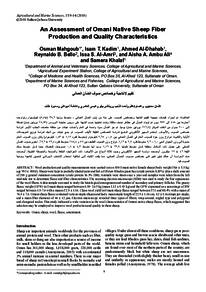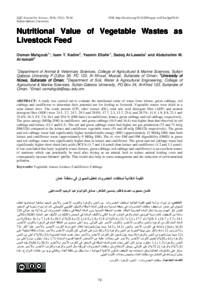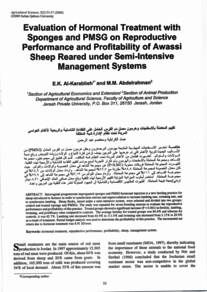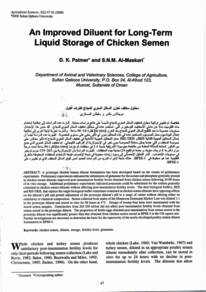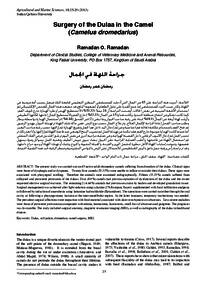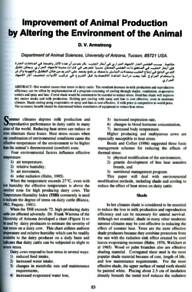Document
An Assessment of Omani Native Sheep Fiber Production and Quality Characteristics.
Contributors
Kadim, Isam T., Author
Al-Dhahab, Ahmed., Author
Bello, Reynaldo B., Author
Al-Amri, Issa S., Author
Publisher
جامعة السلطان قابوس. كلية العلوم الزراعية والبحرية
Gregorian
2010
Language
English
English abstract
Wool production and quality measurements were carried out on 100 Omani native female sheep (body weight 38.6 + 5.5 kg: age 993 + 488 d). Sheep were kept in partially shaded pens and fed ad libitum Rhodes grass hay (crude protein 8.83%) plus a daily amount of 200 g general ruminant concentrate (crude protein 16.5º% DM). Animals were shorn once a year and samples were taken from the lef mid-side site to determine fleece and fiber characteristics. The scanning electron microscope (SEM) was used to study the fine appearance fibers. A skin sample was ed to study the histological arrangement and number of secondary and primary follicles. The greasy of the wo fleece weight (GFW) in Omani sheep ranged between 0.50- 2.65 kg (mean 1.12 ± 0.43 kg) and the GFW expressed as a percentage of BW ranged between 1.0-7.6 with a mean of 2.9 ± 1.16. Clean wool yield in Omani sheep fleece ranged between 57.1 and 88.4% with a mean of 76.4 + 7.6. Omani sheep fleece contained various staple shapes and had a mean staple length of 22.9 ± 1.16 cm. 4.3 ±0.8 crimps per staple; and a mean fiber diameter of 46 + 12 µm. Electron microscopy revealed three types of fibers; wrap-around, angled type and polygonal and elongated scales. This study indicated a wide variation in the wool characteristics of Omani native sheep fleece, which suggested that selection may be employed to improve wool production and quality in these sheep.
Member of
ISSN
2410-1079
Resource URL
Citation
Mahgoub, O., Kadim, I. T., Al-Dhahab, A., Bello, R. B., Al-Amri, I. S., Ambu Ali, A. A., & Khalaf, S. (2010). An Assessment of Omani Native Sheep Fiber Production and Quality Characteristics. Agricultural and Marian Sciences Journal, 15 (1), 9-14.
Arabic abstract
تم إجراء قياسات منهجية لتقييم إنتاجية وخصائص الصوف على مئة من إناث الضأن العماني، متوسط وزنها 38.6 (±5.5) كيولوجرام وتراوحت أعمارها بين 488 إلى 993 يوم . تم إيواء الضأن في حظائر نصف مظللة وتمت تغذيتها حسب الشهية على دريس حشيشة الرودس (8.83% بروتين خام ) إضافة إلى 200 جرام من العلف المركز (16.5% بروتين خام ) يوميا تم جز الضأن مرة واحدة في العام وأخذت عينات من منطقة منتصف الجانب الأيسر لدراسة خصائص الصوف والألياف. استخدم المجهر الإلكتروني الماسح لدراسة الخصائص الدقيقة لألياف الصوف. تم جمع عينات من الجلد الدراسة توزيع الحويصلات الأولية والثانوية. تراوح وزن جزة الصوف الخام في الضأن العماني بين 0.5 و2.65 كيلو جرام ( بمتوسط قدره 1.12 ± 0.43 كيلو جرام ) وكان وزن الصوف الخام منسوبا إلى وزن الحيوان الحي 1.0- 7.6 بمتوسط قدره 2.9 ± 1.16. تراوح وزن الصوف النظيف بين 57 و88.4% بمتوسط قدره 76.4 ± 7.6%. احتوى صوف الضأن العماني على خصل ذات أشكال مختلفة كان متوسط طولها 22.9 ± 1.16 سم، لها موسط 4.3 ± 0.8 تموجات للخصلة ، بينما كان متوسط سمك الليفة 46 ± 12 ميكرون، أوضحت دراسة المجهر الإلكتروني وجود ثلاثة أنواع من الألياف : ذات الحراشيف الملتفة والمسننة والمنبسطة الطويلة. أوضحت هذه الدراسة أن هناك تباين كبير في خصائص صوف الضأن العماني، مما يلفت الانتباه إلى إمكانية استخدام الانتخاب الوراثي لتحسين إنتاجية ونوعية الصوف فيه.
Category
Journal articles

